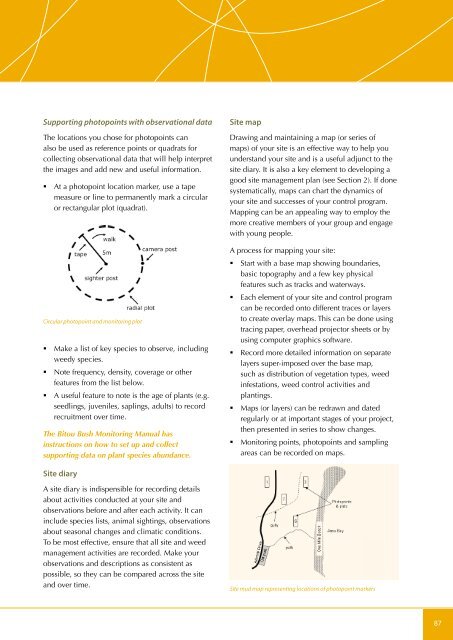Asparagus weeds - Weeds Australia
Asparagus weeds - Weeds Australia
Asparagus weeds - Weeds Australia
- No tags were found...
Create successful ePaper yourself
Turn your PDF publications into a flip-book with our unique Google optimized e-Paper software.
Supporting photopoints with observational dataThe locations you chose for photopoints canalso be used as reference points or quadrats forcollecting observational data that will help interpretthe images and add new and useful information.• At a photopoint location marker, use a tapemeasure or line to permanently mark a circularor rectangular plot (quadrat).Circular photopoint and monitoring plot• Make a list of key species to observe, includingweedy species.• Note frequency, density, coverage or otherfeatures from the list below.• A useful feature to note is the age of plants (e.g.seedlings, juveniles, saplings, adults) to recordrecruitment over time.The Bitou Bush Monitoring Manual hasinstructions on how to set up and collectsupporting data on plant species abundance.Site mapDrawing and maintaining a map (or series ofmaps) of your site is an effective way to help youunderstand your site and is a useful adjunct to thesite diary. It is also a key element to developing agood site management plan (see Section 2). If donesystematically, maps can chart the dynamics ofyour site and successes of your control program.Mapping can be an appealing way to employ themore creative members of your group and engagewith young people.A process for mapping your site:• Start with a base map showing boundaries,basic topography and a few key physicalfeatures such as tracks and waterways.• Each element of your site and control programcan be recorded onto different traces or layersto create overlay maps. This can be done usingtracing paper, overhead projector sheets or byusing computer graphics software.• Record more detailed information on separatelayers super-imposed over the base map,such as distribution of vegetation types, weedinfestations, weed control activities andplantings.• Maps (or layers) can be redrawn and datedregularly or at important stages of your project,then presented in series to show changes.• Monitoring points, photopoints and samplingareas can be recorded on maps.Site diaryA site diary is indispensible for recording detailsabout activities conducted at your site andobservations before and after each activity. It caninclude species lists, animal sightings, observationsabout seasonal changes and climatic conditions.To be most effective, ensure that all site and weedmanagement activities are recorded. Make yourobservations and descriptions as consistent aspossible, so they can be compared across the siteand over time.Site mud map representing locations of photopoint markers87
















